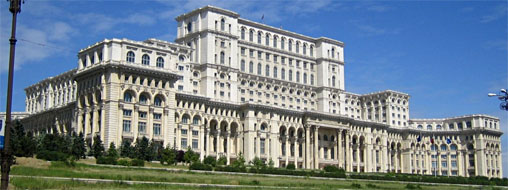ADVERTISEMENT
|
|
|
Romania Travel & Tourism Guide
Politics of Romania
NextGen Day feature Australia links, Australia resources and large selection of Australia budget airlines, Australia chartered planes, Australia sea cruises, Australia ferries, Australia travel agencies, Australia land transports and Australia attractions including Australia beaches, Australia medical tourism, Australia retirement homes, Australia historical and Australia pilgrimage tours. NextGen Day offers travel tips and information for top travel places and best destinations in Africa, Asia, Australia, Europe, Middle East and United States of America.

The Palace of the Parliament the seat of Romania's bicameral parliament. Built in 1984, it is the largest building in Europe and the world's second largest administrative building behind the Pentagon and 10% larger by volume than the Great Pyramid of Giza
The Constitution of Romania is based on the Constitution of France's Fifth Republic and was approved in a national referendum on December 8, 1991. A plebiscite held in October 2003 approved 79 amendments to the Constitution, bringing it into conformity with European Union legislation. Romania is governed on the basis of multi-party democratic system and of the segregation of the legislative, executive and judicial powers. Romania is a semi-presidential democratic republic where executive functions are shared between the president and the prime minister. The President is elected by popular vote for maximum two terms, and since the amendments in 2003, the terms are five years. The President appoints the Prime Minister, who in turn appoints the Council of Ministers. While the president resides at Cotroceni Palace, the Prime Minister with the Romanian Government is based at Victoria Palace.
The legislative branch of the government, collectively known as the Parliament, consists of two chambers – the Senate, which has 140 members, and the Chamber of Deputies, which has 346 members. The members of both chambers are elected every four years under a system of party-list proportional representation.
The justice system is independent of the other branches of government, and is made up of a hierarchical system of courts culminating in the High Court of Cassation and Justice, which is the supreme court of Romania. There are also courts of appeal, county courts and local courts. The Romanian judicial system is strongly influenced by the French model, considering that it is based on civil law and is inquisitorial in nature. The Constitutional Court is responsible for judging the compliance of laws and other state regulations to the Romanian Constitution, which is the fundamental law of the country. The constitution, which was introduced in 1991, can only be amended by a public referendum, the last one being in 2003. Since this amendment, the court's decisions cannot be overruled by any majority of the parliament.
The country's entry into the European Union in 2007 has been a significant influence on its domestic policy. As part of the process, Romania has instituted reforms including judicial reform, increased judicial cooperation with other member states, and measures to combat corruption. Nevertheless, in 2006 Brussels report, Romania and Bulgaria were described as the two most corrupt countries in the EU.
Source: Wikipedia Encyclopedia |

